No CrossRef data available.
Article contents
Sonja Lanehart, Language in African American communities. New York: Routledge, 2023. Pp. 260. Pb. $24.
Review products
Sonja Lanehart, Language in African American communities. New York: Routledge, 2023. Pp. 260. Pb. $24.
Published online by Cambridge University Press: 01 February 2024
Abstract
An abstract is not available for this content so a preview has been provided. Please use the Get access link above for information on how to access this content.

- Type
- Book Notes
- Information
- Copyright
- Copyright © The Author(s), 2024. Published by Cambridge University Press



